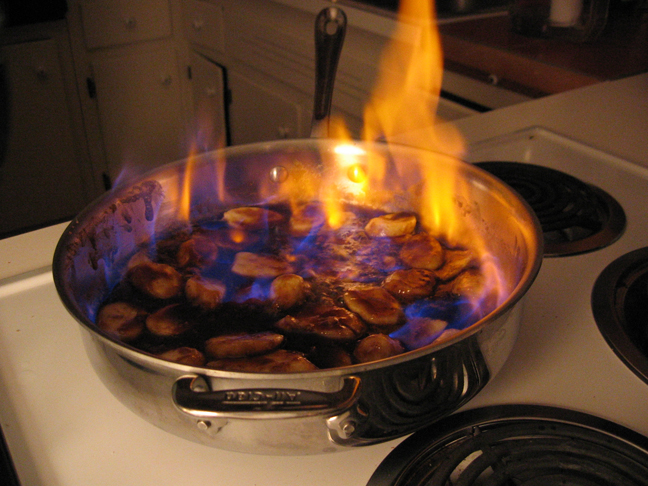Bananas Foster is emblematic of New Orleans. The dish is a combination of New Orleans' long history as a port city and its culinary ingenuity. The famous dessert consists of bananas and vanilla ice cream accompanied by a sauce made from butter, brown sugar, cinnamon, dark rum, and banana liqueur. The butter, sugar, and bananas are sautéed in a pan. Then the alcohol is added and ignited. The bananas and sauce are then put into a serving vessel and served with vanilla ice cream. The ignition of the alcohol, known as a flambé, comes from the heated alcohol vapors and burns off the alcohol in the dish while leaving behind a slightly burnt flavor. The flambé is an attractive table-side presentation at New Orleans restaurants, including Brennan’s, where the dish originated.
Ella Brennan, the famed New Orleans restauranteur who was managing Brennan’s Restaurant in 1951, created the famous dessert on a whim. The restaurant’s owner, Owen Brennan, was hosting a dinner in honor of Richard Foster, the chairman of the New Orleans Crime Commission. As a result, Owen told Ella to whip up a new dessert for their honored guest. She ran back into the kitchen and grabbed some bananas that were laying around. Inspired by a caramelized banana dish her mother would make for breakfast, Ella sautéed the bananas in a pan. Also inspired by the Baked Alaska at nearby Antoine’s, Ella decided to flambé the bananas. The dessert was a hit that night and has been on the menu at Brennan’s ever since.
 |
| Flambé at work |
It is fitting that Ella Brennan selected bananas as the centerpiece of her new dessert. The banana has a long and troubled history in New Orleans. Bananas were not always America’s favorite fruit. Until the 1870s, fresh fruit was difficult to come by. America lacked the infrastructure to move fresh fruit around the country before it spoiled. By the late 1800s, however, the growth of railroads, refrigerated railroad cars, and genetic engineering led to fruit to become a staple of the American diet. New Orleans was at the center of the burgeoning fruit industry. As a large port on the Gulf of Mexico, the Crescent City was the quickest entry for fruit into the United States. Big fruit companies like Standard Fruit and Cuyamel Fruit Company set up their headquarters in New Orleans.
Samuel Zemurray, president of Cuyamel, was the driving force of the banana industry in New Orleans. Zemurray began his career by seizing upon the untapped potential in the banana market—ripe bananas. As the banana market in New Orleans grew, importers discarded ripe bananas, fearing that they would spoil before they reached markets across the country. Zemurray saw an opportunity; he bought up the ripe bananas, arranged a delivery deal with a local railroad, and made a fortune. Zemurray soon bought banana plantations, banana boats, and anything and everything related to banana production. His Cuyamel company quickly became one of the nation’s largest and most powerful companies.
 |
| Sam the Banana Man |
Zemurray’s activities at Cuyamel and later when he ran the United Fruit Company reveal the dark side of the banana business and its history in New Orleans. Workers in New Orleans and on banana plantations in Latin America faced brutal working conditions. Because of the time sensitive nature of harvesting, laborers worked long hours for little pay. They suffered from tropical diseases and were regularly exposed to harmful pesticides. Banana farming also drained the land of nutrients and brought in new destructive fungi, leading banana companies to buy up and discard greater and greater amounts of land. It also angered locals who saw more and more of their land handed over to big corporations and subsequently destroyed. Additionally, Zemurray routinely paid off local governments, seized land from natives, and engaged in other morally questionable business practices.
In 1910, Miguel Dávila came to power in Honduras. He had promised that Honduran people that he would make banana companies like Cuyamel pay their fair share of taxes. For years, companies like Cuyamel, exported bananas and other natural resources from Honduras without paying any taxes. Success in the volatile banana business, Zemurray argued, relied on bribes and kickbacks to the Honduran government, keeping the cost of business low and the profit margins high. As a result, the Honduran government had to borrow large sums of money from American banks. Dávila negotiated a treaty with the United States that would place agents of the J.P. Morgan company in Honduran customs houses, collecting taxes that would pay off Honduras’s debts.
 |
| Workers unloading bananas |
Zemurray, not wanting to pay taxes and fearing the loss of his business, decided to orchestrate a coup against Dávila, led by former president Manuel Bonilla. He provided guns, money, and even bought and outfitted a decommissioned US Naval warship. Secretary of State Philander Knox warned Zemurray not to interfere in Honduras, but Zemurray proceeded with the coup anyway. When Bonilla came to power, he voided the deal with the U.S., protected Zemurray’s interests, and threw Honduras back into crippling debt.
Zemurray did all of this for control of the banana market. Who knew such a little fruit could have such lasting consequences?


No comments:
Post a Comment